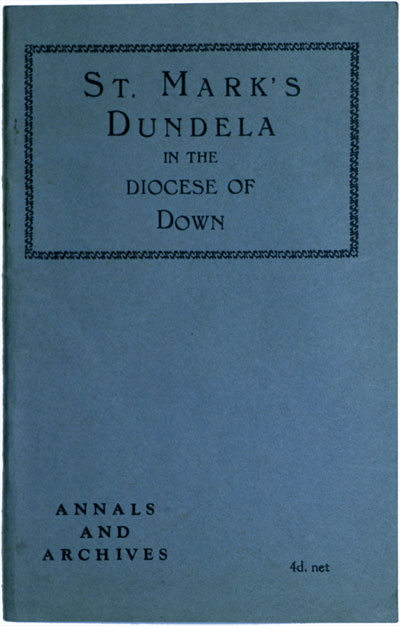
ST. MARK'S DUNDELA
DIOCESE OF DOWN
Its Annals and Archives
Edited by
ERNEST CARLILE HAYES
Rector, Canon of St. Patricks
Printed in Great Britan for the
S. P. C. K.
PREFACE.
DUNDELA: ITS ANNALS AND ARCHIVES
LEST our origin become obscure, and to help our children appreciate their inheritance -- accumulated and bequeathed b their fathers -- these scraps of parish history, rescued from tongues, letters and minutes, are combed out and printed.
It cam to pass that Saul begat Bangor, and Bangor begat Ballymichgan, and Knockbreda and Holywood begat Dundela. And in process of time St. Mark's begat St. Brendan's!
So God's family grows and spreads.
Thus our little corner of Christendom illustrates how the Church began and how only it may expand.
Our story has not yet the glamour of great historic churches. But already it tells of the faith and love of many old ones we still remember: and it stirs our hope for what will yet be accomplished, at home and abroad, by the many young ones we are beginning to know.
THE PARISH OF DUNDELA
ALTHOUGH the parish is a modern foundation, the name from which it bears is an ancient one in the district. In a register compiled in 1302 Dundela is found as the name, apparently, of the ancient church of Knock, which for at least three centuries has lain in ruins, adjoining the Knock graveyard. The name Dundela is believed to be derived from a prehistoric earthwork in the neighbourhood of the ruins.
Within the parish of Dundela, in the grounds of the Moat House, there stood in old times the parish church of Ballymichgan, or Ballymeaghan, which belonged to he famous abbey of Bangor. Nothing now remains of the this church except the name, which survives in the townland of Ballymaghan, and a few sculptured tombstones.
In more modern times Strandtown formed part of the parish of Holywood, and even within living memory it was a small village in a thinly populated countryside. In the middle of last century, however, the population began to increase rather rapidly, and in order to meet the needs of the growing community a few local Churchpeople arranged to have a Church service in the district on Sunday evenings. A coach-house in Sydenham Park, belonging to Mr. Henry Smith, was adapted for this purpose. The congregation soon found the coach-house church too small for them, and their leaders then set to work to erect the building, still standing, at the junction of Holywood Road and Belmont Road, which until quite recently was known and used as Strandtown National School. The first Church service was held here on March 1, 1863. In August of the same year the school-house was set apart as a chapel-of-ease to Holywood parish, and a district, which included a portion of Knockbreda parish, was assigned to it. In 1878, on the consecration of the present church, this district became the separate parish of Dundela. Some small areas were later ceded to the newly formed parishes of Knock and St. Donard's.
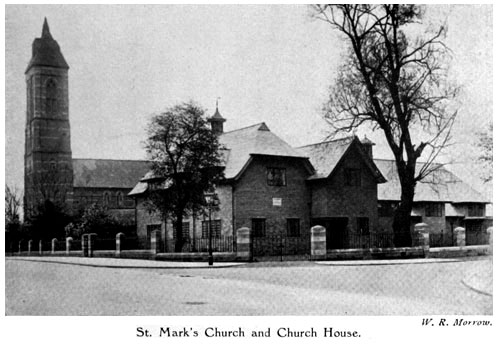
Dundela parish, in the diocese of Down, lies almost entirely within the county borough of Belfast, and is bounded on the west by Belfast lough and the river Connswater, on the south by the Newtownards Road. On its other sides the boundary follows, roughly, that of the county borough, with the important exception that it includes Campbell College. Its Church population at the present time (1932) may be estimated at about 4,500.
THE PARISH CHURCH
St. Mark's Church stands in a prominent position on the slopes of Bunker's Hill, where its massive bell-tower, 150 feet in height, forms a very conspicuouslandmark. This hill, incidentally, according to local tradition, gave its name to the site of a famous battle of the American revolution.
The walls and tower are very solidly constructed of red sandstone from Dundonald. This same material is freely used in the interior, alternating with grey stone, with a somewhat Oriental effect, while the chancel walls are decorated with geometrical designs in mosaic. The general style of the building is described as Gothic of the Decorative period. It is about 150 feet in length and about 60 feet high.
The architect was William Butterfield of London, the designer of several notable church and college buildings at Oxford, Rugby and elsewhere.

The erection of the church actually began in May, 1876, though the formal laying of the foundation stone did not take place till October 13 of that year. This stone is built into the pier on the south side of the choir, and the ceremony was performed by Primate Marcus Gervais Beresford, who was accompanied by the Bishop of the diocese. Fitzpatrick Brothers of Belfast were the contractors.
The building at first consisted only of the nave, aisle, and tower of the present church, and the three arches at the east end were temporarily built up. There was accommodation for a congregation of 500. The original building cost £10,304, of which £3,500 was granted from the Beresford Fund, the balance being raised locally. In the summer of 1878 the new church was finished, and on August 21 a public concert was given in it, conducted by Sir R P. Stewart, to raise the wherewithal to purchase an organ. On the following day, August 22, 1878, the church was consecrated by the Right Rev. R Knox, Bishop of Down, the preacher at the service being Bishop T. B. Lymon of North Carolina.
The Rev. Thomas R. Hamilton, who had been working in the district since 1874, became the first rector of the newly formed parish, and his first churchwardens were William Quartus Ewart and Thomas Scott.
Thirteen years later the church was completed by the erection of the chancel and transepts as a memorial to Sir William Ewart, M.P.
This addition, which increased the seating capacity to about 750, was also designed by Mr. Butterfield, the builders being H. and J. Martin of Belfast. The present vestry was added at the same time.
On July 4, 1891 the new building was consecrated by the Right Rev. William Reeves, Bishop of Down. Primate Knox, who, when Bishop of the diocese, had consecrated the old part of the church, was present at this service, and the sermon was delivered by George Salmon, Provost of Trinity College, Dublin.
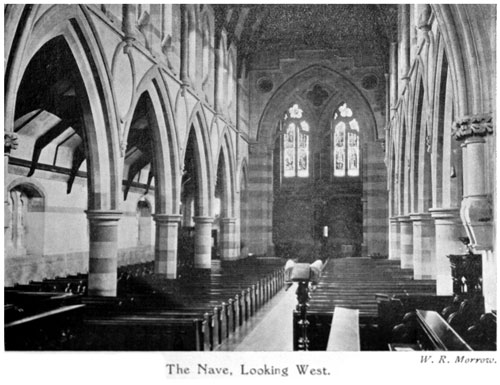
MEMORIALS IN THE PARISH CHURCH
As stated above, the chancel and transepts, built in 1891, were a memorial to Sir William Ewart (d. 1889), one of the founders of the church, and were erected by his widow and children. A marble slab built into the south wall of the chancel bears a commemorative inscription. The east window was given in memory of his wife, Isabella Kelso Ewart (d. 1905), by their surviving children. The window is the work of Powell and Sons of London, and was dedicated in 1913 by the Right Rev. C. F. D'Arcy, now Archbishop of Armagh. The central figure is that of our Lord, attired in priestly robes, and bearing a chalice. In a predella beneath the figure is a reproduction of a picture (by Harold Copping) of the scene at the well of Sychar. The small cinquefoil light above depicts Christ in royal robes, enthroned and crowned, and in the side lights are mary and Martha of Bethany. The inscription is inlaid in a tablet of petrified wood in the north wall of the chancel.
The space under the tower at the west end of the church is used as a baptistery, and in this is placed a fine stained-glass window in honour of men of the parish who fell in the Great War of 1914-18, and whose names are engraved on a brass plate underneath. This window, which is by Shrigley and Hunt of Lancaster, was dedicated on September 25, 1921, by the Bishop of Down.
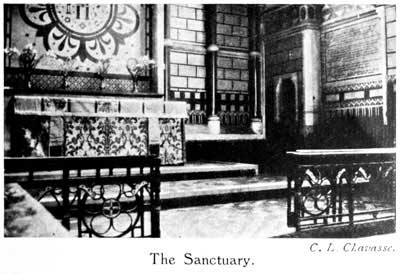
There are four lights, each divided into two panels. The figures in the lower panels are those of St. Patrick, St. Columba, apostle of Scotland, St. George, patron saint of England, and St. David of Wales. Above are shown four great warriors of Israel -- Joshua, Gideon, King David and Judas Maccabaeus. The arms of the diocese and the winged lion of St. Mark are seen in the small upper lights, and on a scroll across the window are written the famous words from the Book of Ecclesiasticus:
"Their seed shall remain for ever and their glory shall not be blotted out.
"Their bodies are buried in peace, but their name liveth for evermore."
The large window in the south transept, by Powell and Sons, has for its subject the Sermon on the Mount. The picture shows our Lord preaching to the people, and sentences from the sermon are displayed on scrolls. This window was given in 1924 as a memorial to Sir William Quartus Ewart (d. 1919) by his window and children.
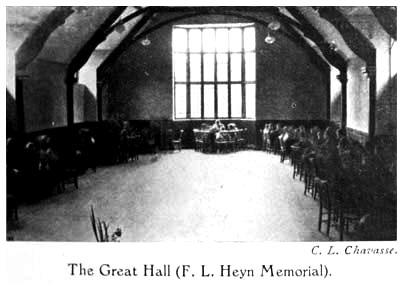
The oldest stained glass in the church is the window at the upper end of the south aisle, in memory of the first rector of the parish, Rev. Thomas R. Hamilton, and its subject is Christ blessing the children.This was erected in 1906, and is the work of Shrigley and Hunt.
The second window in the aisle shows, in its central light, Abraham about to sacrifice his son Isaac. This picture is planked by the figures of David and Jonathan, the three lights symbolizing sacrifice, love, valour. This window was inserted in 1919 in memory of R. Lloyd Thompson (killed in action, 1917), and was the gift of his parents.
The next window is a memorial to Albert James Lewis (d. 1929) and his wife, a daughter of the first rector of the parish, and was erected by their two sons in 1932. The three lights depict St. Luke, St. James and St. Mark, and some local allusions are introduced in the details.
The last window on the south side was erected in 1921 in memory of Miss Katherine M. Henderson. Its three lights bear symbolic figures representing faith, peace and love.
The handsome brass lectern was presented to the church in 1903 as a memorial to Mrs. Martha Lewis, and the communion vessels were given in memory of her husband, Richard Lewis (d. 1908), by their children.
A mural tablet of white and red marble in the south aisle bears an inscription in honour of Mrs. Helen Patterson (d. 1911), and was presented by her family.
There are three brass tablets in the south transept in memory of James Matthewson Ewart (d. 1897), William Quintus Ewart (d. 1900), and Richard Hooker Ewart (d. 1918).

THE ORGAN
The first organ in St. Mark's Church was purchased in 1878 from Lord Inverclyde, in whose private chapel it had previously been used. It had been shown at the Paris Exhibition of1878.
The present organ was the gift of Mrs. Edith Mitchell of Marmont, and was dedicated on St. Mark's Day, 1932, by the Bishop of Kilmore, formerly rector of the parish.
This instrument was constructed by the John Compton Organ Co. of London, and is of the most modern type. The pipes and mechanism are entirely enclosed, except for the three manuals and other controls. Power is supplied by a 71/2 h.p. electric motor, and the action is electrically operated throughout.
The Rectory
St. Mark's Rectory, a substantial building in red brick, adjoining the parish church, was constructed by H. and J. Martin to the plans of Mr. S. P. Close. It was first occupied in May, 1887. "Ravensdale," in Park Avenue, was previously used as a rectory.
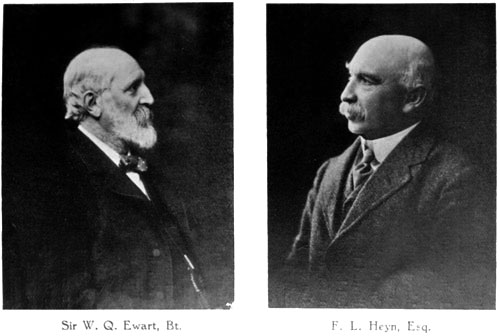
St. Brendan's Church
The origin of St. Brendan's was not unlike that of its mother church. The building of a number of new streets in the Sydenham district attracted to that part of the parish a considerable population, largely connected with the great shipyards, and from the opening years of the century efforts were made to bring the ministrations of the Church to this new community. The parochial authorities rented an upper room in Park Avenue, which served for some years as a mission-hall. These premises (which were shared with a travelling menagerie) did not prove very suitable for the purpose, and a new hall was later secured at the corner of Park Avenue and Lisavon Street. Here a new Sunday School developed, week-night services and meetings were held and a men's club was formed. In 1922 the hall was enlarged, and in October of that year the clergy of the parish began to hold the regular Church service on Sunday evenings. Two years later Rector Barton and the vestry decided to convert the mission-hall into a church. They selected Mr. James Munce as architect, and Messrs. Johnston and Son as contractors, the total cost of the work being about £1,200.
On October 11, 1925, the Bishop of the diocese dedicated the new church, which is a simple but dignified building in plain red brick, with accommodation for a congregation of over 200. It is served by the clergy of the parish church, but has its own officers and committee.
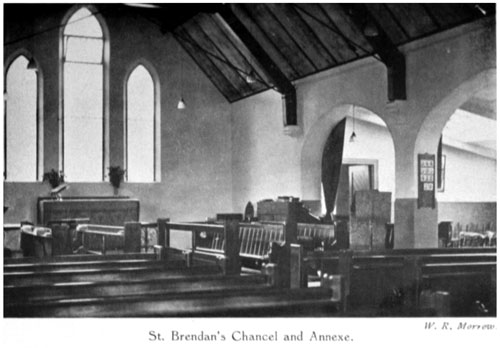
The F. L. Heyn Memorial Church-House
After St. Mark's Church was consecrated in 1878, the parish retained possession of the old church for use as a school and parochial hall, and the Sunday School was held here till 1929. The school-house was also in constant demand for various parochial meetings, and in fact for many years it was the only building available for such purposes.
Though conveniently placed, yet with the steady development of the parish and of the many institutions connected with it, the old school-house came in time to be quite inadequate for the work carried on there, and suggestions were heard that it should be replaced by a more suitable building.
In 1928 the family of Mr. F. L. Heyn, who died on February 2, 1928, offered, as a memorial to him, to provide a Church-house or hall for the parish. Mr. Heyn had been one of the founders of St. MArk's, and remained a devoted member and an active supporter of the parish till his death. This generous offer was accepted, and steps were at once taken to give effect to it. Mr. Henry Seaver was appointed architect, and the building contract was given to F. B. McKee and Co. of Belfast. A suitable site was available beside the church and rectory. The hall was opened and dedicated by the Bishop of Down on October 12, 1929. It is designed in the Tudor style, and is generally considered one of the finest buildings of its kind in the country. The walls are of dark-red Jacobean brick, the roof covered with green Norwegian slates, and Oregon pine is used for panelling in the interior. On the ground floor there is a large hall, 60 feet in length, with a platform or stage for concerts and dramatic performances. Opposite this hall are a library, a scout's den, appropriately walled with rough timber bearing its natural bark, and another large room, elegantly fitted, and known as the Parish Parlour. In the entrance-hall hangs a portrait of Mr. F. L. Heyn, with a memorial tablet under it. On the upper floor is a minor hall or music room. Most of the furniture in the building was presented by various members of the parish.
C.G.E.
PAROCHIAL ANNALS
| 186-(?). | Evening service in coach-house of Mr. Henry Smith of Sydenham Park. |
| 1863, | March 1. First service in school-house by Rev. H. E. Crutwell, Vicar of Holywood. |
| July 12. Full services: Rev. Adrian Lutman. | |
| August 13. Separate district granted, as chapel-of-ease to Holywood. | |
| 1864. | Rev. Rich Burgess Lebarte. |
| April 24. First baptism (Wm. John Holland: Ballyhackamore). | |
| 1872. | Rev. Ambrose Lawson. |
| 1874, | January. Rev. Thos. Robt. Hamilton, M.A., ex-Chaplain, R.N. |
| 1876, | October 13. St. Mark's foundation stone. |
| 1878, | August 22. Consecration of St. Mark's |
| The district then became a separate parish carvedfrom portions of Holywood (Rev. H. E. Crutwell) and Knockbreda (Rev. John Kinahan). | |
| 1879, | February 1. First marriage, R Lush and Jemima Gibb, alias McGee. |
| April 15. First Easter vestry. | |
| 1880, | October 4. Strandtown school established. |
| 1881, | January 11. School taken over by National Board. |
| 1887, | May 1. Rectory occupied: architect, S. P. Close; contractors, H. and J. Martin; grounds laid out by H. Dickson, Belmont Nurseries. |
| 1888. | Church gates and railings (Butterfield). |
| 1891, | July 4. Chancel and transepts and vestry dedicated as memorial to Sir William Ewart. |
| 1900. | Rev. Gerald W. Peacocke instituted. |
| 1903. | The brass lectern (Mrs. Martha Lewis). |
| 1905, | September. Rector Hamilton died. |
| 1906, | September. The Hamilton window erected. |
| 1908. | The communion vessels (Richard Lewis). |
| 1913, | April 27. The East window (Isabella, Lady Ewart). |
| 1914, | March 31. Rev. A. W. Barton, B.D., instituted. |
| 1919. | Electric lighting in St. Mark's. |
| 1919. | The Thompson window. |
| 1920. | Duplex (F.W.O.) introduced by J. A. Stewart. |
| 1921. | War Memorial-west window. |
| 1921. | Henderson window. |
| 1924. | Sir. Wm. Q. Ewart: South transept window. |
| 1924-5. | Parochial School transferred. |
| 1925, | September 23. Canon E. C. Hayes instituted. |
| 1925, | October 11. Dedication of St. Brendan's. |
| 1929, | October 12. Church-house opened as Memorial to Mr. F. L. Heyn. |
| Visit of Rev. L. Gatphoh, of Khasi Hills, Assam. | |
| Concealed electric lighting; Miss Coates donor. | |
| 1930. | Sixteen feet taken off church grounds; railings completed along Sydenham Avenue. |
| 1931, | January 1. Introduction of free seats in St. Mark's. |
| 1932, | April 25. New organ (John Compton) dedicated, the gift of Mrs. Edith Mitchell. |
| 1932, | August 28. The A. J. Lewis window. |
Roll of Clergy
| 1878. | Thomas R Hamilton, M.A. |
| George Foster, B.D. (London), 1895-6. | |
| T. P. Waring, B.A., 1896-99. | |
| M. J. Palmer, B.A., 1890-92. | |
| E. H. Tottenham, 1892-95. | |
| J. A. Greer, LL.D., 1893. | |
| 1900. | Gerald W. Peacocke, M.A. (T.C.D.). |
| W. C. Good, LL.D., locum-tenens 1907-8. | |
| J. H. Kidd, B.A., 1911-13 | |
| J. E. Swinhoe, 1913-15. | |
| 1914. | Arthur William Barton, B.D. (T.C.D.). |
| J. Waring, B.A., 1916-17. | |
| R H. Egar, M.A. (T.C.D.), 1917-29. | |
| William Kelly, B.A., 1919-20. | |
| John Elliott, Wycl. Coll. Tor. (T.C.F.), 1920-21. | |
| David H. Kelly, B.A., ex-Capt., 1923-27. | |
| 1925. | Ernest Wm. Carlile Hayes, M.A. (Camb.). |
| Claude Lionel Chavasse, M.A. (Calcutta). Visitor 1929-30. | |
| Henry Savage, M.A. (T.C.D.), 1932. |
Roll of Churchwardens
| 1878. | Wm. Q. Ewart. |
| Thomas Scott. | |
| 1879. | Thomas Valentine. |
| F. L. Heyn. | |
| 1880. | |
| 1881. | Thomas Valentine. |
| W. Masterson. | |
| 1882. | Th. R. Walkington. |
| Jos. Wellwood. | |
| 1884. | F. L. Heyn. |
| Wm. Masterson. | |
| 1885. | Reuben Payne. |
| Joseph Wellwood. | |
| 1886. | T. R. Walkington |
| David Allen. | |
| 1887. | Richard C. Hyde. |
| J. C. Richards, Capt. | |
| 1889. | Reuben Payne. |
| Hugh Maguire. | |
| 1890. | Reuben Payne. |
| Hugh Maguire. | |
| 1891 | F. L. Heyn. |
| Wm. Masterson. | |
| 1892. | F. L. Heyn. |
| Wm. Masterson. | |
| 1893. | James Turpin. |
| John Balmer. | |
| 1894. | James Turpin |
| John Balmer. | |
| 1895. | Leonard Calvert. |
| Edward Garrett. | |
| 1896. | Leonard Calvert. |
| T. R. Walkington. | |
| 1897. | T. R. Walkington. |
| James Bennett. | |
| 1898. | Joseph Lewis, C.E. |
| James Bennett. | |
| 1899. | Joseph Lewis, C.E. |
| F. L. Heyn. | |
| 1900. | F. L. Heyn, J.P. |
| Joseph Lewis, C E. | |
| 1901. | W. Masterson, J.P. |
| F. J. Brill. | |
| 1902. | W. F. Coates. |
| James A. Thompson. | |
| 1903. | Sir W. Q. Ewart, Bt. |
| J. A. Thompson. | |
| 1904. | Sir W. Q. Ewart, Bt. |
| William Boyd. | |
| 1905. | Albert J. Lewis. |
| William Boyd. | |
| 1906. | A. J. Lewis. |
| J. Pim Thompson. | |
| 1907. | Thomas J. Brittain. |
| J. Pim Thompson. | |
| 1908. | T. J. Brittain |
| Joseph Lewis, C. E. | |
| 1909. | F. L. Heyn, J.P. |
| C. H. Matier. | |
| 1910. | R. F. Davis, M.A. |
| C. H. Matier. | |
| 1911. | R. F. Davis, M.A. |
| C. H. Matier. | |
| 1912. | Jas. A. Thompson. |
| W. F. Minnis. | |
| 1913. | R. H. Ewart. |
| W. F. Minnis. | |
| 1914. | Robt. H. Ewart, M.A. |
| F. L. Heyn. | |
| 1915. | A. J. Lewis. |
| T. Elm. | |
| 1916. | H. V. Coates. |
| T. Elm. | |
| 1917. | H. Irwin. |
| J. McComish. | |
| 1918. | R. Wellwood. |
| J. Watterson. | |
| 1919. | J. A. Thompson. |
| J. Watterson. | |
| 1920. | J. A. Thompson. |
| T. E. Wheatley. | |
| 1921. | Gordon Ewart, M.A. |
| E. Wheatley. | |
| 1922. | Gordon Ewart, M.A. |
| W. F. Minnis. | |
| 1923. | F. L. Heyn, J.P. |
| W. F. Minnis. | |
| 1924. | R. F. Davis, M.A. |
| W. Mussen. | |
| 1925. | R. F. Davis, M.A. |
| William Mussen. | |
| 1926. | J. A. Stewart. |
| William Hamilton. | |
| 1927. | William F. Minnis, J.P. |
| William Hamilton. | |
| 1928. | C. Gordon Ewart, M.A. |
| William Hamilton. | |
| 1929. | Barry Meglaughlin. Master. |
| Alfred W. Greeves. | |
| 1910. | William Hamilton. |
| Alfred W. Greeves. | |
| 1931. | J. Gordon Douglas. |
| R. J. Campbell, M.B.E. | |
| 1932. | W. E. Armstrong. |
| R. J. Campbell, M.B.E. |
Hon. Secretary of the Vestry, H. V. Coates.
Roll of Organists
W. J. Kempton.
William Hill.
E. M. Chaundy, Mus.D.
J. F. Neile.
W. A. Crone.
R. A. Longman.
Fredk. J. Powell, Mus.B.
J. H. MacBratney.
Roll of Sexton and Vergers
Joseph Palmer.
John Sweet.
John Heggerty.
R Morrow, 1914.
Still Waiting to be Undertaken!
1. Completion of tiled dado round the church.
2. Mosaics in vesicas and spandrils of nave.
3. Peal of bells [was suggested in 1919 as War Memorial].
4. Sexton's house.
5. Clock.
6. Windows of north aisle, south chancel, transept, and west lights.
[Note. -- A scheme of connected subjects is being planned. Donors will be asked to choose one or other of the set.]
7. Chairs may still be adopted as memorial; in the church-house.
PRINTED IN GREAT BRITAIN BY
BILLING AND SONS LTD., GUILFORD AND ESHER

